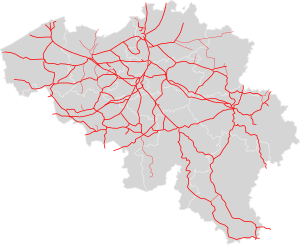National Railway Company of Belgium
 | |
| NMBS/SNCB (the SNCB abbreviation is increasingly more used recently in English language publicity) | |
Native name | Dutch: Nationale Maatschappij der Belgische Spoorwegen French: Société nationale des chemins de fer belges German: Nationale Gesellschaft der Belgischen Eisenbahnen |
| Type | Statutory corporation |
| Industry | Rail Transport |
| Founded | 1926 |
| Founder | Government of Belgium |
| Headquarters | Avenue de la Porte de Hal/Hallepoortlaan 40, 1060 Brussels , |
| Products | Rail Transport |
| Revenue | |
Number of employees | 18,688 (2005) |
| Subsidiaries | NMBS/SNCB Logistics and more |
| Website | belgiantrain |
The National Railway Company of Belgium (Dutch: Nationale Maatschappij der Belgische Spoorwegen, or NMBS;[note 1] French: Société nationale des chemins de fer belges, or SNCB; German: Nationale Gesellschaft der Belgischen Eisenbahnen) is the national railway company of Belgium. The company formally styles itself using the Dutch and French abbreviations NMBS/SNCB. The corporate logo designed in 1936 by Henry van de Velde consists of the linguistically neutral letter B in a horizontal oval.
History[]
NMBS/SNCB is an autonomous government company, formed in 1926 as successor to the Belgian State Railways. In 2005, the company was split up into three parts: Infrabel, which manages the railway infrastructure, network operations and network access, the public railway operator NMBS/SNCB itself to manage the freight (B-Cargo) and passenger services, and NMBS/SNCB-Holding, which owns both public companies and supervises the collaboration between them. Essentially, this was a move to facilitate future liberalisation of railway freight and passenger services in agreement with European regulations. Several freight operators have since received access permissions for the Belgian network. In February 2011, NMBS/SNCB Logistics began operating as a separate business.[1]
Faced with rising losses, in June 2012, the Belgian transport minister announced further reform: NMBS/SNCB Holding would be split up, so NMBS/SNCB (the train operator) would be separate from Infrabel (the infrastructure owner). Unions oppose the reform.[2]
NMBS/SNCB-Holding was merged into SNCB in 2014 in order to simplify the structure of the Belgian railways.[3]
NMBS/SNCB holds a Royal Warrant from the Court of Belgium.[4]
Operations[]

In 2008 NMBS/SNCB carried 207 million passengers[5] a total of 8,676 million passenger-kilometres over a network of 3,536 kilometres (of which 2,950 km are electrified, mainly at 3000 V DC and 351 km at 25 kV 50 Hz AC). In 2017, that number rose to 230 million passengers carried,[6] and Belgium has a rail network of 3,602 km of main railway lines (or 6,399 km of mainline tracks).
The network currently includes four high speed lines suitable for 300 km/h (190 mph) traffic: HSL 1 runs from just south of Brussels to the French border, where it continues to a triangular junction with LGV Nord for Paris Nord and Lille Flandres (and London beyond that), HSL 2 runs from Leuven to Ans and onward to Liège-Guillemins, HSL 3 runs from Liège to the German border near Aachen and HSL 4 connects with HSL-Zuid in the Netherlands to allow services to run from Antwerpen-Centraal to Rotterdam Centraal.
National enforcement body[]
Sometimes passengers are not satisfied with the answer of railway companies or passengers do not receive any answer in one month,[7] in which case they can seek the assistance of the Federal Public Service Mobility and Transport.[8]
Gallery[]
NMBS/SNCB MS08/AM08 Desiro train in Antwerp Central Railway Station

NMBS/SNCB M7 double-decker train

NMBS/SNCB M6 double-decker train

Brussels Central Railway Station's main hall

NMBS/SNCB MS08/AM08 Desiro train in Leuven Railway Station

Wezemaal station in 2020 before the renovation works, with old station sign

NMBS/SNCB totem pole in station Kiewit in 2020

NMBS/SNCB MS08/AM08 Desiro train in Kiewit

Station Begijnendijk in 2020

Station Bouwel with NMBS/SNCB logo with level crossing signaling

NMBS/SNCB Logo in Brussels-North station
See also[]
- Eurostar - NMBS/SNCB holds a 5% stake[9]
- History of rail transport in Belgium
- List of railway lines in Belgium
- List of SNCB/NMBS classes
- Rail transport in Belgium
- Thalys
- Transportation in Belgium
Notes[]
- ^
 pronunciation (help·info)
pronunciation (help·info)
References[]
- ^ "Railway Gazette: SNCB Logistics gains independence". Retrieved 13 February 2011.
- ^ "Reforms proposed to cut SNCB losses – Railway Gazette". Railway Gazette International. Retrieved 26 June 2012.
- ^ "History of the Belgian railways". Infrabel. Retrieved 12 May 2018.
- ^ "The Royal Novelist: Royal Trains - Royal Research". 21 October 2018.
- ^ (in French) Jobs B-Rail. Jobs.b-rail.be.
- ^ (in French) 230 millions de voyageurs ont pris le train en 2017. SNCB Corporate.
- ^ "1371/2007/EC".
- ^ "National Enforcement Bodies in Europe for rail passengers" (PDF). European Commission.
- ^ Larry Elliott (13 October 2014). "UK government to sell Eurostar stake before general election". The Guardian.
External links[]
| Wikimedia Commons has media related to National Railway Company of Belgium. |
- Bueker.net – Map of the Belgian, Dutch and Luxembourg rail networks
- SNCB website
- List of stations: Liste des gares SNCB (in French) - Lijst van NMBS-stations (in Dutch)
- Collection of Google Earth locations of SNCB stations (requires Google Earth software) from the Google Earth Community forum.
- Documents and clippings about National Railway Company of Belgium in the 20th Century Press Archives of the ZBW
- Railway companies of Belgium
- Eurostar
- Railteam
- Belgian companies established in 1926
- Railway companies established in 1926
- Belgian brands
- Government-owned companies of Belgium
- Government agencies established in 1926
- Government-owned railway companies











